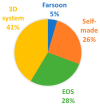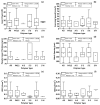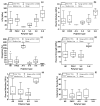Laser Powder Bed Fusion of Polymers: Quantitative Research Direction Indices
- PMID: 33801512
- PMCID: PMC7958861
- DOI: 10.3390/ma14051169
Laser Powder Bed Fusion of Polymers: Quantitative Research Direction Indices
Abstract
Research on Laser Powder Bed Fusion (L-PBF) of polymer powder feedstocks has raised over the last decade due to the increased utilization of the fabricated parts in aerospace, automotive, electronics, and healthcare applications. A total of 600 Science Citation Indexed articles were published on the topic of L-PBF of polymer powder feedstocks in the last decade, being cited more than 10,000 times leading to an h-index of 46. This study statistically evaluates the 100 most cited articles to extract reported material, process, and as-built part properties to analyze the research trends. PA12, PEEK, and TPU are the most employed polymer powder feedstocks, while size, flowability, and thermal behavior are the standardly reported material properties. Likewise, process properties such as laser power, scanning speed, hatch spacing, powder layer thickness, volumetric energy density, and areal energy density are extracted and evaluated. In addition, material and process properties of the as-built parts such as tensile test, flexural test, and volumetric porosity contents are analyzed. The incorporation of additives is found to be an effective route to enhance mechanical and functional properties. Carbon-based additives are typically employed in applications where mechanical properties are essential. Carbon fibers, Ca-phosphates, and SiO2 are the most reported additives in the evaluated SCI-expanded articles for L-PBF of polymer powder feedstocks. A comprehensive data matrix is extracted from the evaluated SCI-index publications, and a principal component analysis (PCA) is performed to explore correlations between reported material, process, and as-built parts.
Keywords: 3D-printing; PA12; PEEK; SLS; additive manufacturing; additives; bibliometry; nano; selective laser sintering.
Conflict of interest statement
The authors declare no conflict of interest.
Figures














References
-
- Campbell I., Diegel O., Kowen J., Wohlers T. Wohlers Report. 3D Printing and Additive Manufacturing State of the Industry. Wohlers Associates; Fort Collins, CO, USA: 2019.
-
- Kusoglu I.M., Gökce B., Barcikowski S. Research trends in laser powder bed fusion of Al alloys within the last decade. Addit. Manuf. 2020;36:101489. doi: 10.1016/j.addma.2020.101489. - DOI
-
- Wang X., Jiang M., Zhou Z., Gou J., Hui D. 3D printing of polymer matrix composites: A review and prospective. Compos. Part. B Eng. 2017;110:442–458. doi: 10.1016/j.compositesb.2016.11.034. - DOI
-
- Yuan S., Shen F., Chua C.K., Zhou K. Polymeric composites for powder-based additive manufacturing: Materials and applications. Prog. Polym. Sci. 2019;91:141–168. doi: 10.1016/j.progpolymsci.2018.11.001. - DOI
Publication types
Grants and funding
LinkOut - more resources
Full Text Sources
Other Literature Sources

